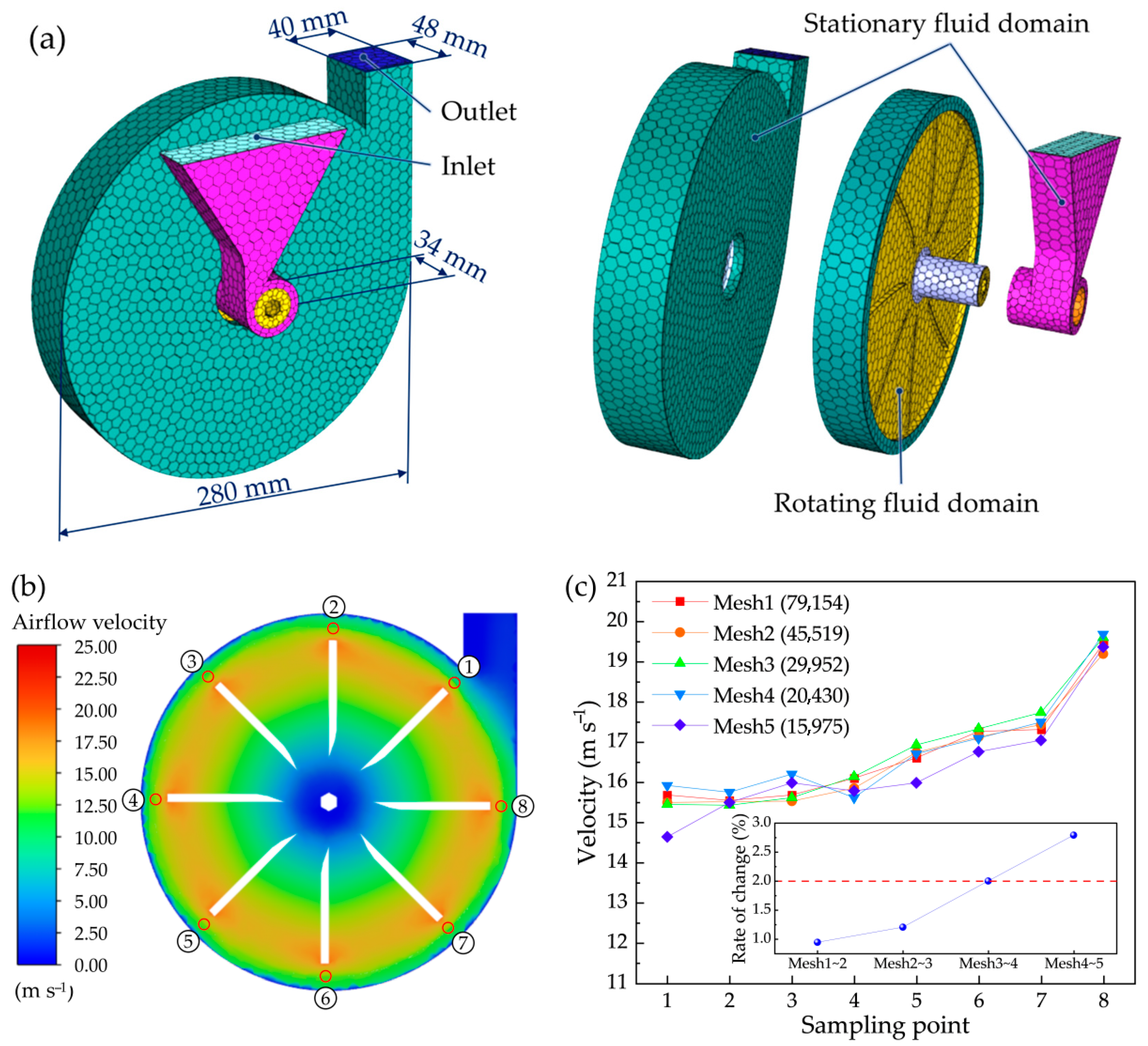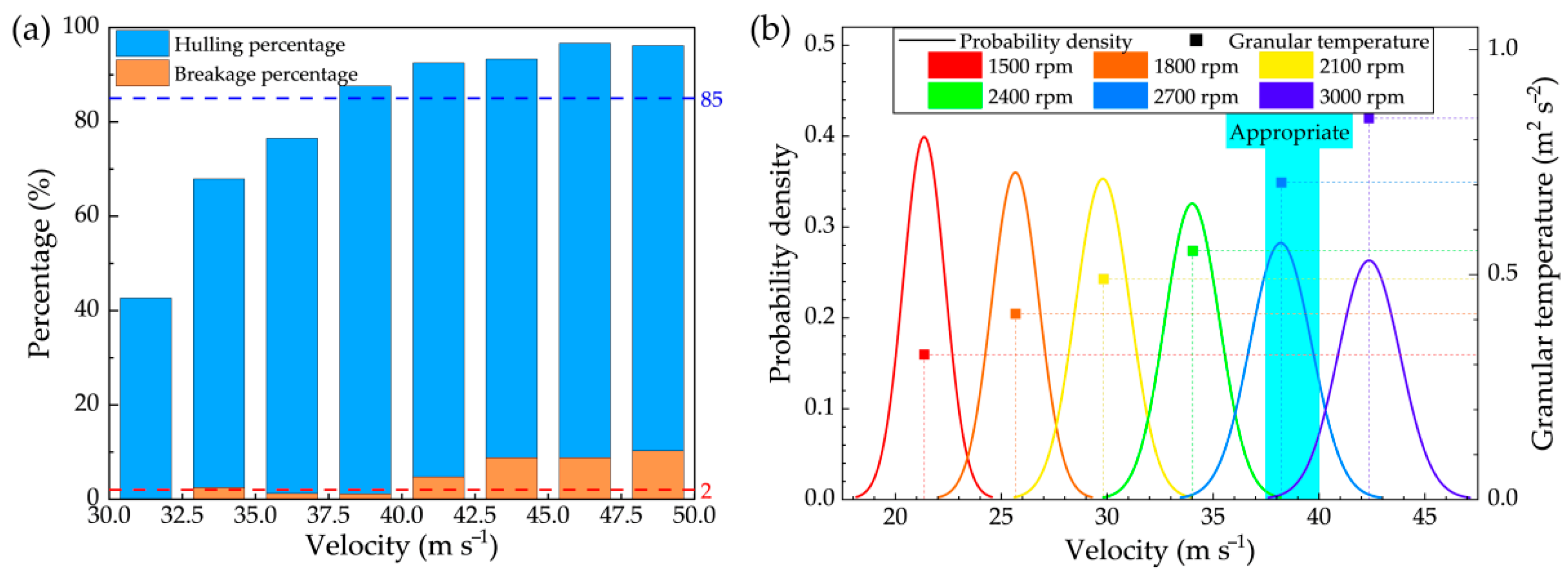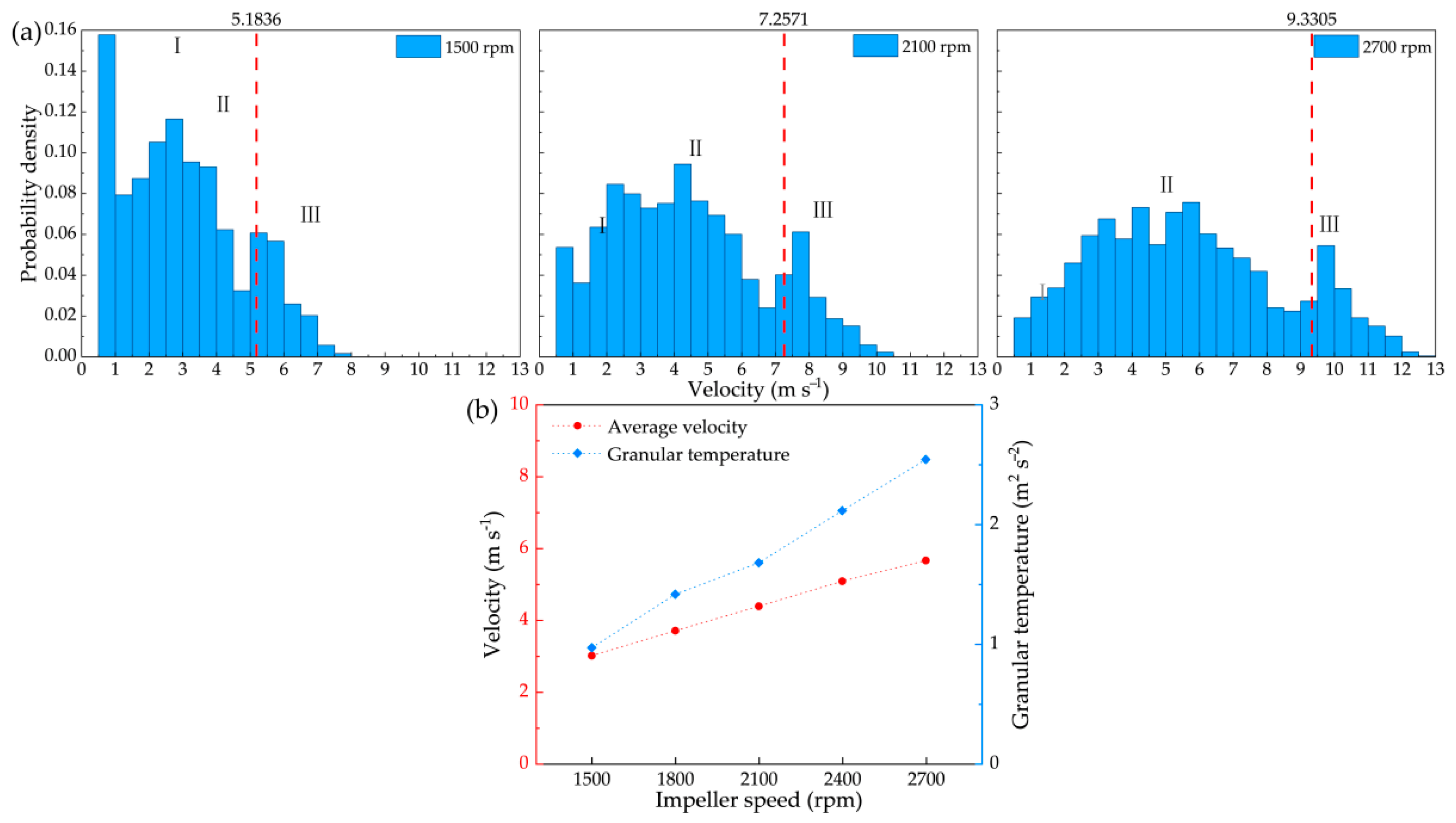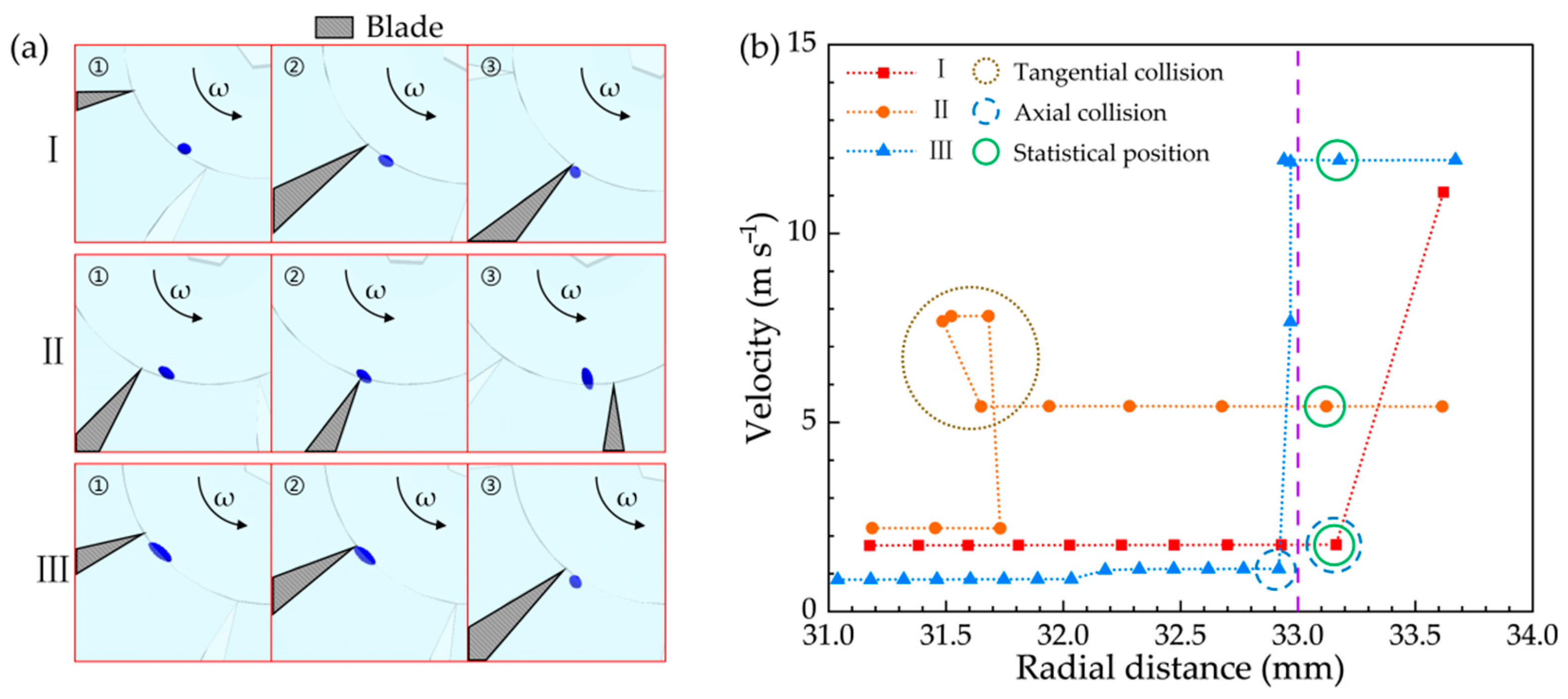Study of the Formation Mechanism of Velocity Differences Among Paddy Grains Within Centrifugal Hullers Using CFD-DEM Coupling
Abstract
1. Introduction
2. Materials and Methods
2.1. Experiment
2.1.1. Materials and Equipment
2.1.2. Single Paddy Grain Impact Experiment
2.2. Numerical Simulations
2.2.1. Mathematical Model
2.2.2. DEM Model of Particles
2.2.3. CFD Model of Geometry
2.2.4. DEM Model of Geometry
2.2.5. Simulation Parameters and Conditions
2.3. Verification of Simulation Accuracy
3. Results
3.1. Interaction Mechanisms Between Paddy Grains and Blades During the Feeding Stage
3.2. Collision Behaviour Between Paddy Grains and Blades During the Accelerating Stage
3.3. Velocity Distribution Trends in the Paddy Grain Population
3.4. Influence of Airflow on Velocity Differences
3.5. Tilted Curvature Blade Design
4. Discussion
5. Conclusions
- The different forms of collision between the paddy grains and the blades during the feeding stage were identified as the primary cause of the velocity differences, with tangential collisions playing a dominant role. These differences increased with higher impeller speeds.
- Axial collisions between paddy grains and blades during the accelerating stage were identified as the primary cause of velocity differences. The jumping degree (Sv) parameter was demonstrated to effectively quantify the relative motion of paddy grains to the blades. Increasing the initial velocity of the paddy grains and reducing the radial distance of the initial collision facilitated the convergence of the jumping degree towards unity, thereby reducing velocity differences.
- The velocity of the paddy grain population increased with radial distance, with velocity differences initially decreasing and then increasing. The velocity distribution of the paddy grain population initially exhibited a bimodal distribution due to varying axial collision positions. Following the transition to a unimodal distribution, velocity differences gradually increased due to system instability and particle characteristics. Notably, the strong airflow generated by the impeller was identified as one of the contributing factors to increased velocity differences.
- A tilted curvature blade design was developed to minimise velocity differences among paddy grains. The results demonstrate that the configuration with a 300 mm radius of curvature and 20° tilt angle achieves a 27.5% reduction in velocity differences. Experimental verification confirmed that this optimised design improves hulling efficiency by 4.5%. This enhancement holds significant practical implications for agricultural processing operations.
Author Contributions
Funding
Data Availability Statement
Conflicts of Interest
Abbreviations
| CFD | Computational Fluid Dynamics |
| DEM | Discrete Element Method |
References
- Chu, Y.; Han, Y.; Jia, F.; Wang, Y.; Chen, P.; Meng, X.; Li, A. Analysis of the impact hulling behaviour of paddy grains. Biosyst. Eng. 2022, 220, 243–257. [Google Scholar] [CrossRef]
- Li, A.; Jia, F.; Chu, Y.; Han, Y.; Li, H.; Sun, Z.; Ji, S.; Li, Z. Simulation of the movement of rice grains in a centrifugal huller by discrete element method and the influence of blade shape. Biosyst. Eng. 2023, 236, 54–70. [Google Scholar] [CrossRef]
- Han, Y.; Zhao, D.; Chu, Y.; Zhen, J.; Li, G.; Zhao, H.; Jia, F. Breakage behaviour of single rice particles under compression and impact. Adv. Powder Technol. 2021, 32, 4635–4650. [Google Scholar] [CrossRef]
- Tang, H.; Zhu, G.; Xu, W.; Xu, C.; Wang, J. Discrete element method simulation of rice grains impact fracture characteristics. Biosyst. Eng. 2024, 237, 50–70. [Google Scholar] [CrossRef]
- Tang, H.; Zhu, G.; Sun, Z.; Xu, C.; Wang, J. Impact damage evolution rules of maize kernel based on FEM. Biosyst. Eng. 2024, 247, 162–174. [Google Scholar] [CrossRef]
- Hashmi, A.; Ito, N. Determining effects of impeller peripheral area on husking properties of rice. J. Soc. High Technol. Agric. 2003, 15, 140–148. [Google Scholar] [CrossRef]
- Khodabakhshian, R.; Bayati, M. Investigation into the effects of impeller vane patterns and pistachio nut size on hulling efficiency of pistachio nuts using a centrifugal huller. J. Food Process. Technol. 2011, 2, 3. [Google Scholar] [CrossRef]
- Umani, K.C.; Olatunji, O.M.; Ekop, I.E.; Akpan, G.E. Experimental investigation of the effect of rotor speed of a horizontal shaft centrifugal palm nut cracker on optimum whole kernel production and shell particle size. Sci. Afr. 2020, 7, e00238. [Google Scholar] [CrossRef]
- Wang, X.; Ito, N.; Miwa, K.; Kito, K.; Wang, X. Studies on friction and impact characteristics of impeller type rice husker (Part 2)—Design of blade shape with frictional energy. J. Jpn. Soc. Agric. Mach. 1997, 59, 11–19. [Google Scholar] [CrossRef]
- Kamide, J.; Tsuchiya, M.; Akase, A. The study on an impeller type rice huller (II)—The motion of a grain and hulling action on the blade of an impeller. J. Jpn. Soc. Agric. Mach. 1980, 42, 491–497. [Google Scholar] [CrossRef]
- Nishiyama, Y.; Shisai, T. Dynamical analysis of impeller-type rice husker. J. Jpn. Soc. Agric. Mach. 1991, 53, 227–228. (In Japanese) [Google Scholar] [CrossRef]
- Lachuga, Y.; Ibyatov, R.; Ziganshin, B.; Shogenov, Y.; Dmitriev, A. Simulation of the grain trajectory along working bodies of the pneumatic mechanical dehuller. Russ. Agricult. Sci. 2020, 46, 534–538. [Google Scholar] [CrossRef]
- Lachuga, Y.; Ibyatov, R.; Shogenov, Y.; Ziganshin, B.; Dmitriev, A. Method for estimating grain motion trajectory in a pneumomechanical husking machine. Russ. Agricult. Sci. 2021, 47, S106–S110. [Google Scholar] [CrossRef]
- Lachuga, Y.; Ibyatov, R.; Shogenov, Y.; Ziganshin, B.; Dmitriev, A. Results of numerical calculation of grain movement in a pneumatic mechanical huller. Russ. Agricult. Sci. 2022, 48, 521–526. [Google Scholar] [CrossRef]
- Li, A.; Jia, F.; Zhang, J.; Han, Y.; Meng, X.; Chen, P. The effects of filling level on the milling accuracy of rice in the friction rice mill. Powder Technol. 2021, 398, 117052. [Google Scholar] [CrossRef]
- Li, H.; Li, Y.; Fang, G.; Zhan, Z.; Xu, L. CFD-DEM simulation of material motion in air-and-screen cleaning device. Comput. Electron. Agric. 2012, 88, 111–119. [Google Scholar] [CrossRef]
- Yuan, J.; Wu, C.; Li, H.; Qi, X.; Xiao, X.; Shi, X. Movement rules and screening characteristics of rice-threshed mixture separation through a cylinder sieve. Comput. Electron. Agric. 2018, 154, 320–329. [Google Scholar] [CrossRef]
- Amjad, W.; Chen, Z.; Ambrose, K. Design assessment of grain inverters in cross-flow grain dryer via CFD-DEM numerical simulation. Biosyst. Eng. 2024, 239, 147–157. [Google Scholar] [CrossRef]
- Liu, H.; He, Y.; Tang, T.; Zhai, M. Prediction of the non-uniform drying of wet grain in a fluidised-bed based on a modified CFD-DEM drying model. Biosyst. Eng. 2023, 236, 103–119. [Google Scholar] [CrossRef]
- Chen, P.; Han, Y.; Jia, F.; Zhao, D.; Meng, X.; Li, A.; Chu, Y.; Zhao, H. Investigation of the mechanism of aerodynamic separation of rice husks from brown rice following paddy hulling by coupled CFD-DEM. Biosyst. Eng. 2022, 218, 200–215. [Google Scholar] [CrossRef]
- Shitanda, D.; Nishiyama, Y.; Koide, S. Husking characteristics of short and long grain rice by rubber roll husker (part 1)—Dynamic analysis of a single grain motion. J. Jpn. Soc. Agric. Mach. 2001, 63, 55–63. [Google Scholar] [CrossRef]
- Fei, J.; Feng, W.; Jia, F.; Han, Y.; Chen, P.; Li, A.; Wang, Y.; Zhang, J.; Shen, S.; Hao, X. The mechanism of bran layer removal in friction rice mills. Biosyst. Eng. 2023, 229, 85–95. [Google Scholar] [CrossRef]
- Alsharifi, S.; Arabhosseini, A.; Kianmehr, M.; Kermani, A. Effect of moisture content, clearance and machine type on some qualitative characteristics of rice (Tarm hashemi) cultivar. Bulgar. J. Agricult. Sci. 2017, 23, 348–355. [Google Scholar]
- Cavalcanti, P.; Petit, H.; Thomazini, A.; Carvalho, R.; Tavares, L. Modeling of degradation by impact of individual iron ore pellets. Powder Technol. 2021, 378, 795–807. [Google Scholar] [CrossRef]
- Tong, Z.; Yang, R.; Yu, A.; Adi, S.; Chan, H. Numerical modelling of the breakage of loose agglomerates of fine particles. Powder Technol. 2009, 196, 213–221. [Google Scholar] [CrossRef]
- Jiang, S.; Ye, Y.; Tan, Y.; Liu, S.; Liu, J.; Zhang, H.; Yang, D. Discrete element simulation of particle motion in ball mills based on similarity. Powder Technol. 2018, 335, 91–102. [Google Scholar] [CrossRef]
- Han, Y.; Jia, F.; Zeng, Y.; Jiang, L.; Zhang, Y.; Cao, B. Effects of rotation speed and outlet opening on particle flow in a vertical rice mill. Powder Technol. 2016, 297, 153–164. [Google Scholar] [CrossRef]
- Han, Y.; Zhao, D.; Jia, F.; Qiu, H.; Li, A.; Bai, S. Experimental and numerical investigation on the shape approximation of rice particle by multi-sphere particle models. Adv. Powder Technol. 2020, 31, 1574e1586. [Google Scholar] [CrossRef]
- Arocena, V.M.; Danao, L.A.M. Improving the modeling of pressure pulsation and cavitation prediction in a double-volute double-suction pump using mosaic meshing technology. Processes 2023, 11, 660. [Google Scholar] [CrossRef]
- Hua, C.; Liang, W.; Li, F.; Zhu, Q.; Li, Q.; Chen, L. Preliminary design and hydrodynamic study of power-driven float pole system in Pacific saury fishery. Ocean Eng. 2024, 308, 117990. [Google Scholar] [CrossRef]
- GB/T 29898; Grain and Oil Machinery—Rubber Roll Husker. General Administration of Quality Supervision, Inspection and Quarantine of China, Standardization Administration of China: Beijing, China, 2013.
- Brennen, C. Fundamentals of Multiphase Flow; Cambridge University Press: Cambridge, UK, 2005. [Google Scholar]
- Nishiyama, Y. Dynamical Analysis of Impeller-type Rice Husker (Part 1)—Theoretical Equations and the Laws of Proportion for Grain-Impeller Dynamics. J. Jpn. Soc. Agric. Mach. 1991, 53, 71–76. [Google Scholar] [CrossRef]
- Thornton, S.T.; Marion, J.B. Collisions and Systems of Particles, Chapter 9. In Classical Dynamics of Particles and Systems, 5th ed.; Academic Press International Edition: London, UK, 2004. [Google Scholar]
- Ji, S.; Li, A.; Han, Y.; Li, H.; Sun, Z.; Zhao, D.; Gao, H. Numerical study on the influence mechanism of feed rate on separation quality in a multi-baffle separation duct. Biosyst. Eng. 2025, 258, 104258. [Google Scholar] [CrossRef]
- Singh, S.M.; Joshi, J.; Rao, P.S. Technological advancements in millet dehulling and polishing process: An insight into pretreatment methods, machineries and impact on nutritional quality. Grain Oil Sci. Technol. 2024, 7, 186–195. [Google Scholar] [CrossRef]
- Singh, S.M.; Rao, P.S. Impact dehulling of browntop millet: Its physical and nutritional characterization. J. Cereal Sci. 2025, 121, 104078. [Google Scholar] [CrossRef]
- Liang, Z.; Wada, M.E. Parameter optimisation of a centrifugal fan for rice combine harvesters based on airflow resistance coefficients and CFD simulations. Biosyst. Eng. 2025, 259, 104287. [Google Scholar] [CrossRef]
- Gupta, R.K.; Das, S.K. Performance of centrifugal dehulling system for sunflower seeds. J. Food Eng. 1999, 42, 191–198. [Google Scholar] [CrossRef]
- Doehlert, D.C.; Wiesenborn, D.P.; McMullen, M.S.; Ohm, J.B.; Riveland, N.R. Effects of Impact Dehuller Rotor Speed on Dehulling Characteristics of Diverse Oat Genotypes Grown in Different Environments. Cereal Chem. 2009, 86, 653–660. [Google Scholar] [CrossRef]
- Figueiredo, A.K.; Rodríguez, L.M.; Lindström, L.I.; Riccobene, I.C.; Nolasco, S.M. Performance analysis of a dehulling system for safflower grains. Ind. Crops Prod. 2013, 43, 311–317. [Google Scholar] [CrossRef]
















| Name | Parameters | Value |
|---|---|---|
| Paddy | Density (kg m−3) | 1.38 × 103 |
| Poisson’s ratio | 0.3 | |
| Shear modulus (MPa) | 2.6 | |
| Geometry | Density (kg m−3) | 7.8 × 103 |
| Poisson’s ratio | 0.3 | |
| Shear modulus (MPa) | 7 × 102 | |
| Air | Density (kg m−3) | 1.225 |
| Viscosity (kg m−1 s−1) | 1.7894 × 10−5 | |
| Paddy-Paddy | Restitution coefficient | 0.2 |
| Static friction coefficient | 0.67 | |
| Rolling friction coefficient | 0.01 | |
| Paddy-Geometry | Restitution coefficient | 0.5 |
| Static friction coefficient | 0.58 | |
| Rolling friction coefficient | 0.01 |
| Name | vx1 (m s−1) | v’y1 (m s−1) | r1 (mm) | Impeller Speed (rpm) | e |
|---|---|---|---|---|---|
| case 1 | 0 | 0 | 33 | 2700 | 0.58 |
| case 2 | 0 | 0 | 43 | 2700 | 0.58 |
| case 3 | 5 | 0 | 33 | 2700 | 0.58 |
| case 4 | 0 | 5 | 33 | 2700 | 0.58 |
Disclaimer/Publisher’s Note: The statements, opinions and data contained in all publications are solely those of the individual author(s) and contributor(s) and not of MDPI and/or the editor(s). MDPI and/or the editor(s) disclaim responsibility for any injury to people or property resulting from any ideas, methods, instructions or products referred to in the content. |
© 2025 by the authors. Licensee MDPI, Basel, Switzerland. This article is an open access article distributed under the terms and conditions of the Creative Commons Attribution (CC BY) license (https://creativecommons.org/licenses/by/4.0/).
Share and Cite
Li, H.; Gao, H.; Zhao, D.; Sun, Z.; Wang, X.; Li, X.; Yu, H. Study of the Formation Mechanism of Velocity Differences Among Paddy Grains Within Centrifugal Hullers Using CFD-DEM Coupling. Agriculture 2025, 15, 2380. https://doi.org/10.3390/agriculture15222380
Li H, Gao H, Zhao D, Sun Z, Wang X, Li X, Yu H. Study of the Formation Mechanism of Velocity Differences Among Paddy Grains Within Centrifugal Hullers Using CFD-DEM Coupling. Agriculture. 2025; 15(22):2380. https://doi.org/10.3390/agriculture15222380
Chicago/Turabian StyleLi, Hao, Haonan Gao, Dan Zhao, Ze Sun, Xinlei Wang, Xianle Li, and Hanlin Yu. 2025. "Study of the Formation Mechanism of Velocity Differences Among Paddy Grains Within Centrifugal Hullers Using CFD-DEM Coupling" Agriculture 15, no. 22: 2380. https://doi.org/10.3390/agriculture15222380
APA StyleLi, H., Gao, H., Zhao, D., Sun, Z., Wang, X., Li, X., & Yu, H. (2025). Study of the Formation Mechanism of Velocity Differences Among Paddy Grains Within Centrifugal Hullers Using CFD-DEM Coupling. Agriculture, 15(22), 2380. https://doi.org/10.3390/agriculture15222380





